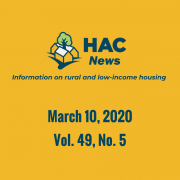Discussion Paper, Partnerships
PARTNERSHIPS AND COLLABORATION FOR RURAL HOUSING
 Continue the Discussionby David Haney, Wyoming CD Authority, and Marcia Erickson, GROW South Dakota
Continue the Discussionby David Haney, Wyoming CD Authority, and Marcia Erickson, GROW South Dakota
Background
Resources for community and economic development – both human capital and dollars – continue to dwindle across rural America. As rural housing organizations seek ways to continue their work, one strategy that seems to have promise is creation of effective partnerships. Those engaged in rural housing development need to be appropriately partnering and aligning with those who focus on other elements such as telecommunications, transportation, education, and healthcare. When various parties can reach consensus about the most important priorities, the multiple voices of conflicting interests can speak more clearly and with greater impact.
Regionalization also has considerable merit. Gathering a number of small diverse rural communities together into a louder and more consistent voice can increase impact. Best practices can be shared or integrated.
Affiliated organizations may consider merging to reduce redundancy. For example, consolidation of core operating functions can cut costs.
Issues and Challenges
Partnerships may be very formal or informal or can be as simple as sharing, but they are not always easy. Numerous issues may arise. For example, frequently participants lay claim to their own specialty or territory, making it extremely difficult to create a successful consensus or collaboration. In addition, one partner may bring greater financial or leadership resources to a collaboration that creates an imbalance of power. It can be challenging to break down traditional silos that exist between organizations and to move beyond an “us vs. them” mentality. For partnerships to be effective, each partner organization must understand not only its own strengths, but the strengths of the associated organizations as well.
Regionalization can be an effective way to partner, although it requires significant effort on the part of all organizations involved. Effective partnerships must maintain mutual trust and respect. This requires any imbalances, including those in financial or leadership resources, to be addressed. Organizations must work together to effectively prioritize needs and goals so that they may share accountability, an effort that can be challenging if the partners do not share core missions and goals.
Discussion Questions
- What capacity building is needed? What role can HAC play in furthering constructive partnerships?
- How do we prioritize needs, while still maintaining an inventory of future issues, to avoid missing key priorities?
- Can you identify best practices from your region or community?
- Are there trends at the state or federal level that are promoting collaboration, partnerships, or mergers?


